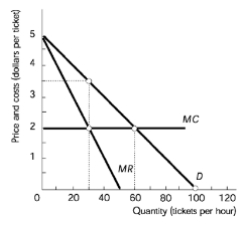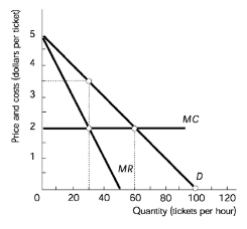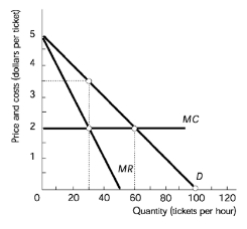Alright. So now let's discuss the idea of consumer and producer surplus in a monopoly as well as the ideas of efficiency, productive and allocative efficiency or the lack thereof. Let's check it out. So what we're going to see is that a monopoly always produces less than the efficient quantity, right? The efficient quantity is something like what we saw in perfect competition where they were reaching efficiency, well here they produce less, okay? So we'll see that on the graph and what happens? We're not producing the efficient quantity, we're producing less than that efficient quantity. Well, when we're not producing the efficient quantity, we're going to have a deadweight loss. Okay? So there's going to be a deadweight loss in the market for a monopoly. Okay? So let's go down here on the graph and let's discuss this producer and consumer surplus under perfect competition first. So we'll see how it is efficient and then we'll move on to a monopoly and see where the deadweight loss
- 0. Basic Principles of Economics1h 5m
- Introduction to Economics3m
- People Are Rational2m
- People Respond to Incentives1m
- Scarcity and Choice2m
- Marginal Analysis9m
- Allocative Efficiency, Productive Efficiency, and Equality7m
- Positive and Normative Analysis7m
- Microeconomics vs. Macroeconomics2m
- Factors of Production5m
- Circular Flow Diagram5m
- Graphing Review10m
- Percentage and Decimal Review4m
- Fractions Review2m
- 1. Reading and Understanding Graphs59m
- 2. Introductory Economic Models1h 10m
- 3. The Market Forces of Supply and Demand2h 26m
- Competitive Markets10m
- The Demand Curve13m
- Shifts in the Demand Curve24m
- Movement Along a Demand Curve5m
- The Supply Curve9m
- Shifts in the Supply Curve22m
- Movement Along a Supply Curve3m
- Market Equilibrium8m
- Using the Supply and Demand Curves to Find Equilibrium3m
- Effects of Surplus3m
- Effects of Shortage2m
- Supply and Demand: Quantitative Analysis40m
- 4. Elasticity2h 16m
- Percentage Change and Price Elasticity of Demand10m
- Elasticity and the Midpoint Method20m
- Price Elasticity of Demand on a Graph11m
- Determinants of Price Elasticity of Demand6m
- Total Revenue Test13m
- Total Revenue Along a Linear Demand Curve14m
- Income Elasticity of Demand23m
- Cross-Price Elasticity of Demand11m
- Price Elasticity of Supply12m
- Price Elasticity of Supply on a Graph3m
- Elasticity Summary9m
- 5. Consumer and Producer Surplus; Price Ceilings and Floors3h 45m
- Consumer Surplus and Willingness to Pay38m
- Producer Surplus and Willingness to Sell26m
- Economic Surplus and Efficiency18m
- Quantitative Analysis of Consumer and Producer Surplus at Equilibrium28m
- Price Ceilings, Price Floors, and Black Markets38m
- Quantitative Analysis of Price Ceilings and Price Floors: Finding Points20m
- Quantitative Analysis of Price Ceilings and Price Floors: Finding Areas54m
- 6. Introduction to Taxes and Subsidies1h 46m
- 7. Externalities1h 12m
- 8. The Types of Goods1h 13m
- 9. International Trade1h 16m
- 10. The Costs of Production2h 35m
- 11. Perfect Competition2h 23m
- Introduction to the Four Market Models2m
- Characteristics of Perfect Competition6m
- Revenue in Perfect Competition14m
- Perfect Competition Profit on the Graph20m
- Short Run Shutdown Decision33m
- Long Run Entry and Exit Decision18m
- Individual Supply Curve in the Short Run and Long Run6m
- Market Supply Curve in the Short Run and Long Run9m
- Long Run Equilibrium12m
- Perfect Competition and Efficiency15m
- Four Market Model Summary: Perfect Competition5m
- 12. Monopoly2h 13m
- Characteristics of Monopoly21m
- Monopoly Revenue12m
- Monopoly Profit on the Graph16m
- Monopoly Efficiency and Deadweight Loss20m
- Price Discrimination22m
- Antitrust Laws and Government Regulation of Monopolies11m
- Mergers and the Herfindahl-Hirschman Index (HHI)17m
- Four Firm Concentration Ratio6m
- Four Market Model Summary: Monopoly4m
- 13. Monopolistic Competition1h 9m
- 14. Oligopoly1h 26m
- 15. Markets for the Factors of Production1h 33m
- The Production Function and Marginal Revenue Product16m
- Demand for Labor in Perfect Competition7m
- Shifts in Labor Demand13m
- Supply of Labor in Perfect Competition7m
- Shifts in Labor Supply5m
- Differences in Wages6m
- Discrimination6m
- Other Factors of Production: Land and Capital5m
- Unions6m
- Monopsony11m
- Bilateral Monopoly5m
- 16. Income Inequality and Poverty35m
- 17. Asymmetric Information, Voting, and Public Choice39m
- 18. Consumer Choice and Behavioral Economics1h 16m
Monopoly Efficiency and Deadweight Loss - Online Tutor, Practice Problems & Exam Prep
 Created using AI
Created using AIIn a monopoly, the quantity produced is always less than the efficient quantity, leading to deadweight loss. Consumer surplus decreases due to higher prices, while producer surplus may increase, but not without losses in potential trades. Monopolies lack both productive efficiency, as they do not produce at minimum average total cost, and allocative efficiency, since marginal benefits exceed marginal costs. Understanding these concepts is crucial for grasping market structures and their implications on economic surplus and efficiency.
Monopolies do not produce the efficient quantity.
Monopoly Efficiency and Deadweight Loss
Video transcript
An unregulated monopoly will sell:
If the monopolist's fixed cost is $25, the monopoly's total costs when maximizing profit is:
If the monopolist's fixed cost is $25, the monopoly's total economic profit when maximizing profit is:
The deadweight loss created by the monopoly is:
Here’s what students ask on this topic:
What is deadweight loss in a monopoly?
Deadweight loss in a monopoly refers to the loss of economic efficiency that occurs when the equilibrium quantity of a good is not produced. In a monopoly, the firm restricts output to maximize profits, producing less than the efficient quantity. This results in a higher price and a reduction in consumer surplus. The trades that do not occur due to this restricted output represent the deadweight loss. Mathematically, deadweight loss can be visualized on a graph as the area between the demand and supply curves, from the monopoly quantity to the efficient quantity.
 Created using AI
Created using AIHow does a monopoly affect consumer and producer surplus?
In a monopoly, consumer surplus decreases because the monopolist sets a higher price and produces a lower quantity compared to a perfectly competitive market. Consumer surplus is the area above the price and below the demand curve, and this area shrinks in a monopoly. Producer surplus, which is the area below the price and above the supply curve, may increase because the monopolist can charge a higher price. However, the total economic surplus (consumer surplus + producer surplus) decreases due to the deadweight loss, which represents the trades that do not occur.
 Created using AI
Created using AIWhy do monopolies lack productive efficiency?
Monopolies lack productive efficiency because they do not produce at the minimum average total cost (ATC). Productive efficiency occurs when a firm produces at the lowest possible cost, which is at the minimum point of the ATC curve. In a monopoly, the firm produces at a quantity where the ATC is not minimized, often on the downward-sloping part of the ATC curve. This results in higher production costs and inefficiency compared to a perfectly competitive market where firms produce at the minimum ATC.
 Created using AI
Created using AIWhat is allocative efficiency and why don't monopolies achieve it?
Allocative efficiency occurs when the production of goods and services aligns with consumer preferences, meaning the marginal benefit to consumers equals the marginal cost of production. In a monopoly, allocative efficiency is not achieved because the monopolist produces less than the efficient quantity. The marginal benefit to consumers exceeds the marginal cost, indicating that more of the good should be produced to meet consumer demand. This misalignment results in a deadweight loss and a loss of economic welfare.
 Created using AI
Created using AIHow does a monopoly create deadweight loss?
A monopoly creates deadweight loss by producing less than the efficient quantity of a good. The monopolist restricts output to raise prices and maximize profits, leading to a quantity that is lower than what would be produced in a perfectly competitive market. This restriction results in some mutually beneficial trades not occurring, which is represented by the deadweight loss. On a graph, deadweight loss is the area between the demand and supply curves from the monopoly quantity to the efficient quantity, indicating the loss of total economic surplus.
 Created using AI
Created using AI



